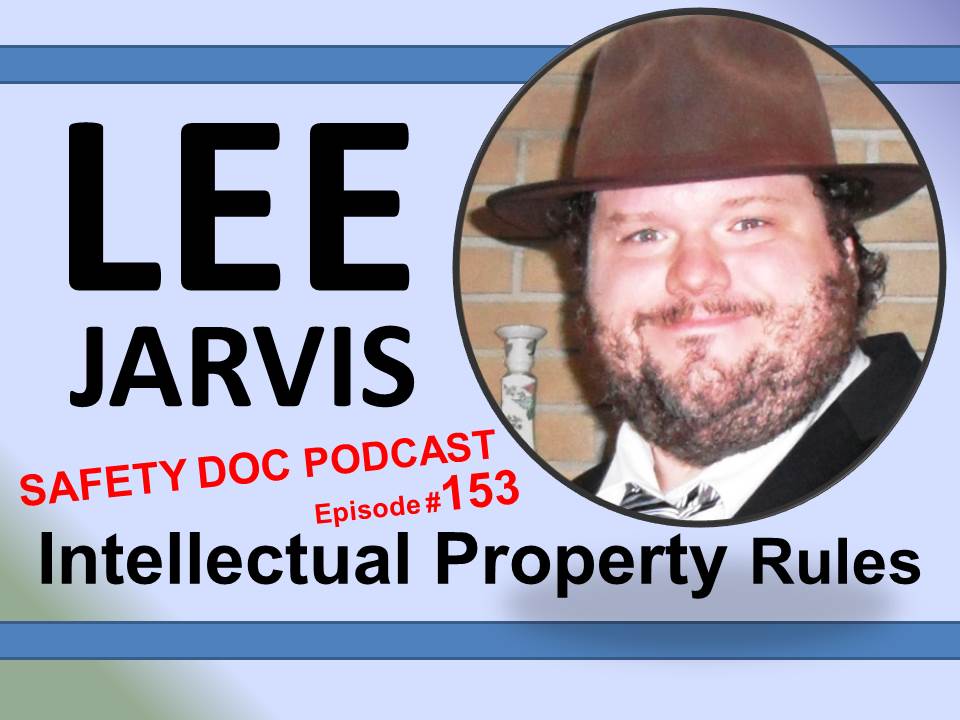Intellectual Property for the Everyday Internet User | Lee Jarvis | SDP153 Livestream 12-27-2020
[Podcast] Lee Jarvis is an Analyzer of Data Processes. He has much knowledge about intellectual property and critical considerations for bloggers, podcasters, social media influencers, and the person in charge of adding uplifting cartoons or images to the church bulletin. What happens if you post a copyrighted image to your blog? How about streaming a minute of copyrighted video within your podcast? How do we fix this mess? **LEE AND DAVID ARE NOT LAWYERS. THIS EPISODE DOES NOT CONSTITUTE LEGAL ADVICE ABOUT INTELLECTUAL PROPERTY. Read the full blog post for this episode at safetyphd.com.

DIRECT LINK to MP3 of this Episode: https://tinyurl.com/SDP153-AUDIO
PANDEMIC RELIEF BILL MIGHT IMPACT CONTENT STREAMERS.
Lawmakers slipped multiple copyright bills, including the CASE Act and a felony streaming law, into the $2.3 trillion spending and economic-relief legislation in December, 2020. The CASE ACT, for example, would create a small claims copyright court and a new U.S. law could hit streamers with felony charges for streaming copyrighted content.
WHAT IS INTELLECTUAL PROPERTY?
Lee explains what IP is, why IP laws were made, what they cover, including copyright and patent, and the differences between patents, trademarks, and copyrights. Trademarks, for example, often expire after just 3 years while copyrights can exist for more than 70 years. Per Wipo, intellectual property (IP) refers to “creations of the mind, such as inventions; literary and artistic works; designs; and symbols, names and images used in commerce.” We often think of photos and songs as intellectual property.
WHAT IS FAIR USE?
Lee notes that Fair Use largely hinges on two points. First, is the content copyrighted? Second, did the person distribute it. Per Copyright.Gov, “Fair use is a legal doctrine that promotes freedom of expression by permitting the unlicensed use of copyright-protected works in certain circumstances. Section 107 of the Copyright Act provides the statutory framework for determining whether something is a fair use and identifies certain types of uses—such as criticism, comment, news reporting, teaching, scholarship, and research—as examples of activities that may qualify as fair use.” However, a judge would determine if Fair Use was a valid “defense” in a lawsuit.
WHAT IS CREATIVE COMMONS?
Creative Commons is an internationally active non-profit organisation that provides free licences for creators to use when making their work available to the public. This means that they only need to seek the creator’s permission when they want to use the work in a way not permitted by the license. CC was instrumental in facilitating the Open COVID Pledge, which calls on organizations around the world to make their patents and copyrights freely available in the fight against the COVID-19 pandemic.
PROBLEMS WITH IP IN CURRENT TIMES AND HOW IT COULD COMPLICATE COLLABORATION IN A CRISIS
Problems with IP in current times and how it impacts people. Lee unpacks complicated laws, banned accounts, blocked content, and censorship. There’s also a cottage industry of third party “IP enforcers” with practices that border on extortion when they threaten huge fines after their Internet-scanning software locates IP on web pages, such as a copyrighted image posted in a personal blog. Such businesses might not give a cent of recovered money to the copyright owner.
IP IN THE TIME OF COVID
Doc adds that a recent study revealed that 3000 people contributed intellectual input to develop schematics for both home and commercial printing of face masks, face shields, and ventilator parts in response to COVID19 pandemic demands. This mass collaboration might be impossible with increased IP monitoring and enforcement. There is no amnesty for people that violate IP during times of crises, although some manufacturers eased IP protections during COVID.
HOW TO IMPROVE IP
Unless changes are made to IP, Lee envisions scenarios of IP infringement claims overwhelming courts, IP creators stifled as they aren’t being properly compensated for their efforts, and hesitation from content users as they don’t want to be sued for potentially copyrighted material. Lee explores improvements such as expanding Fair Use, fines for false claims of IP infringement, or creating a new system of IP. Although overhauling IP is daunting, consider that most songs today are legally downloaded from Amazon or iTunes whereas many were illegally shared on Napster or Limewire in the 1990s.
This is episode 153 of The Safety Doc Podcast published on 12-27-2020.
FOLLOW
- Watch this episode on “The Safety Doc” YouTube channel https://tinyurl.com/SDP153-VIDEO
- Listen to this episode on PodBean MP3 https://tinyurl.com/SDP153-AUDIO
- Apple Podcasts http://tinyurl.com/SafetyDocApplePodcasts
- The 405 Media http://the405media.com/the-safety-doc/
- SAFETY DOC WEBSITE & BLOG safetyphd.com
- Follow David & The Safety Doc Podcast on Twitter @SafetyPhD
- Email Dr. Perrodin thesafetydoc@gmail.com
Purchase Dr. Perrodin’s book: Schools of Errors – Rethinking School Safety in America

